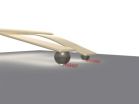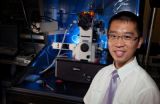(Press-News.org) Scientists at the research centre MEMBRANES at Aarhus University, Denmark, have completed an old puzzle, which since the 60s from many sides has been regarded as impossible to complete. The challenge was to solve the structure of the protecting protein complex that forms when haemoglobin is released from red cells and becomes toxic. This toxic release of haemoglobin occurs in many diseases affecting red cell stability, e.g. malaria.
Technically, the most important finding in this report in Nature is a high-resolution three-dimensional mapping of the so-called 'haptoglobin-haemoglobin complex'.
"After many failing experiments, our breakthrough came when we gave up using human material and went to the local slaughterhouse to purchase pig blood. Not a particular high-technological approach, but this transition from studying human blood to blood from a species with close homology had magic effects. After running into dead ends for two years and trying out the most complex gene-technological ways to produce the right material, it suddenly worked", says Søren Kragh Moestrup, the head of the research group at Department of Biomedicine.
The discovery provides new essential information on haemoglobin that makes up most of the red cell interior. Haemoglobin is an essential blood component for transport of oxygen, but it becomes toxic with potential damaging effects on tissues, in particular the kidneys, when it is released from the red cells. An excessive release can occur in many diseases, such as malaria and other infections.
However, the body has a sophisticated defence system. The first line defence is carried out by the blood protein haptoglobin, which captures haemoglobin and gates it to a receptor that engulfs the haemoglobin-haptoglobin complex. This function of the receptor named CD163 was originally discovered by the same group.
"We have now shown how this unique protein complex forms by generation of a detailed 3-dimensional map of each atom. This shows for the first time how the complex is formed and explains the tight protein association", says PhD Christian Brix Folsted Andersen. He has together with Master's student Morten Torvund-Jensen been an essential driving force in the project.
The results have also led to an unexpected discovery of a novel type of protein structure and a new patent submission on exploitation of the discovery for use in generation of a new type of synthetic proteins to be used in therapy and diagnostics.
###
The Nature paper "Structure of the haptoglobin-haemoglobin complex" is available.
MEMBRANES is a research centre at Aarhus University with focus on membrane proteins.
The present international and interdisciplinary project has been headed by Department of Biomedicine, Aarhus University, with participation of Science & Technology, Aarhus University and experts from Brazil and Norway.
Financial support from The Lundbeck Foundation, The Novo Nordisk Foundation, The Research Council of Norway, The European Research Council and The Danish Council for Independent Research.
More information:
Professor, DMSc Søren Kragh Moestrup, MEMBRANES, Department of Biomedicine, Aarhus University, Denmark. Mobile +45 28 99 22 82; skm@biokemi.au.dk
Assistant professor, PhD Christian Brix Folsted Andersen, MEMBRANES, Department of Biomedicine, Aarhus University, Denmark. Mobile + 45 30 26 48 55; cbfa@biokemi.au.dk
Danish scientists solve old blood mystery
New intriguing knowledge on blood haemoglobin has just been published in Nature
2012-08-31
ELSE PRESS RELEASES FROM THIS DATE:
Glass shape influences how quickly we drink alcohol
2012-08-31
Dr Angela Attwood and colleagues from Bristol's School of Experimental Psychology recruited 160 social drinkers aged 18-40 with no history of alcoholism to attend two experimental sessions. At one session they were asked to drink either lager or a non-alcoholic soft drink from either a straight-sided glass or a curved 'beer flute'.
The participants were almost twice as slow when drinking alcohol from the straight-sided glass compared to the curved glass. There was no difference in drinking rates from the glasses when the drink was non-alcoholic.
The researchers suggest ...
Researchers develop new, less expensive nanolithography technique
2012-08-31
Researchers from North Carolina State University have developed a new nanolithography technique that is less expensive than other approaches and can be used to create technologies with biomedical applications.
"Among other things, this type of lithography can be used to manufacture chips for use in biological sensors that can identify target molecules, such as proteins or genetic material associated with specific medical conditions," says Dr. Albena Ivanisevic, co-author of a paper describing the research. Ivanisevic is an associate professor of materials science and ...
Fear and driving opportunity motivated changes in driving behavior after 9/11
2012-08-31
A catastrophic event – such as a terrorist attack, a natural disaster, or market collapse – often strikes twice. There is the damage caused by the event itself, as lives are lost or left in ruin. But there is also the second act, catalyzed by our response to the catastrophic event. This second act has the potential to cause just as much damage as the first.
In the year following the terrorist attacks of September 11, 2001, there were approximately 1,600 more traffic fatalities in the United States than expected. This figure suggests the possibility that fear may have ...
Research yields two 'firsts' regarding protein crucial to human cardiac function
2012-08-31
TALLAHASSEE, Fla. -- Florida State University researchers led by physics doctoral student Campion Loong have achieved significant benchmarks in a study of the human cardiac protein alpha-tropomyosin, which is an essential, molecular-level component that controls the heart's contraction on every beat.
Using an imaging method called atomic force microscopy, Loong achieved two "firsts": the first direct imaging of individual alpha-tropomyosin molecules, which are very small — roughly 40 nanometers long — and the first demonstrated examples of a measure of the human cardiac ...
BUSM researchers study use of MRI in osteoarthritis
2012-08-31
(Boston) – A study conducted by researchers at Boston University School of Medicine (BUSM) shows that magnetic resonance imaging (MRI) detected a high prevalence of abnormalities associated with knee osteoarthritis in middle-aged and elderly patients that had no evidence of knee osteoarthritis in X-ray images.
Ali Guermazi, MD, PhD, professor of radiology at BUSM and chief of Musculoskeletal Imaging at Boston Medical Center (BMC), led this study in collaboration with researchers from Lund University in Sweden, Brigham and Women's Hospital in Boston and Klinikum Augsburg ...
BUSM researchers find potential key to halt progression, reverse damage from emphysema
2012-08-31
(Boston) – A study led by researchers at Boston University School of Medicine (BUSM) has shown that a compound used in some skin creams may halt the progression of emphysema and reverse some of the damage caused by the disease. When the compound Gly-His-Lys (GHK) was applied to lung cells from patients with emphysema, normal gene activity in altered cells was restored and damaged aspects of cellular function were repaired.
The study, which is published in BioMed Central's open access journal Genome Medicine, also demonstrates the potential impact of using genomic technologies ...
Mobile apps for diabetes present usability issues for older adults
2012-08-31
Diabetes is prevalent among adults aged 65 and older and can lead to a number of other serious health issues. Maintaining control of blood glucose levels is one of the most important actions diabetics can take to control their illness. New technology is designed to make self-monitoring easier and more accessible than ever before, but often tech products fail to accommodate some older users. Human factors/ergonomics researchers Laura A. Whitlock and Anne Collins McLaughlin evaluated the usability issues that older adults may experience with one type of emerging technology, ...
Wayne State researchers say adolescent smoking prevention programs still critical
2012-08-31
DETROIT — While many might see the case for programs to prevent adolescent cigarette smoking as already made, a pair of Wayne State University researchers believes that due to increasingly challenging economic times, policymakers need to be reminded to continue allocating funding for such programs.
Xinguang Chen, M.D., Ph.D., professor of pediatrics in the School of Medicine, and Feng Lin, Ph.D., professor of electrical and computer engineering in the College of Engineering, have found a way to provide policymakers with some hard evidence.
Most adult smokers in the ...
AGU journal highlights -- 31 August 2012
2012-08-31
The following highlights summarize research papers that have been recently
published in Geophysical Research Letters (GRL), Journal of Geophysical
Research - Biogeosciences (JGR-G), Journal of Geophysical Research -
Atmospheres (JGR-D), Water Resources Research (WRR), and Space Weather
(SW).
In this release:
1. Trade-offs between water for food and for curbing climate change
2. Low calcification in corals in the Great Barrier Reef
3. The Everglades still threatened by excess nutrients
4. Wetlands the primary source of Amazon Basin methane
5. Old fractures ...
Cleveland Clinic researchers investigating potential drug for treatment of Alzheimer's disease
2012-08-31
Friday, Aug. 31, 2012, Cleveland: A compound developed to treat neuropathic pain has shown potential as an innovative treatment for Alzheimer's disease, according to a study by researchers at Cleveland Clinic's Lerner Research Institute and Anesthesiology Institute.
"Cleveland Clinic dedicated two years of research into the examination of this compound and our findings show it could represent a novel therapeutic target in the treatment of Alzheimer's disease," said Mohamed Naguib, M.D., Professor of Anesthesiology, Cleveland Clinic Lerner College of Medicine. "Development ...
LAST 30 PRESS RELEASES:
Rare image of Tatooine-like planet is closest to its twin stars yet
Music: Popular song lyrics have become more negative since 1973
Marine ecology: Killer whales tail dolphins to hunt salmon
ADHD prescriptions on the rise, study finds
How to build a genome
Sharp rise in ADHD stimulant prescriptions in Ontario, research finds
Trends and prevalence of the metabolic syndrome among US adults
Population-level trends in ADHD medication prescribing
Missing piece of myelin disturbs the brain’s rhythm
Insilico Medicine and Taigen achieves license agreement to develop and commercialize AI-driven PHD inhibitor for anemia of Chronic Kidney Disease (CKD)
Exploring dominant endophytic Pleosporales in grasses: New taxonomic insights in the suborder Massarineae
Comparative transcriptomic analysis of human maxillary and mandibular tooth germs reveals discrepancies in gene expression patterns
Scientists detect atmosphere on molten rocky exoplanet - study
Chip-scale magnetometer uses light for high-precision magnetic sensing
Illinois Tech biomedical engineering professor Philip R. Troyk elected as Fellow of the National Academy of Inventors
The National Academy of Inventors welcomes 2025 Class of Fellows
Multi-scale modelling framework predicts mechanical responses of Fe–Cr–Al alloys across composition and processing conditions
Preoperative radiation may improve antitumor immune response in most common form of breast cancer
Breast MRI may be safely omitted from diagnostic workup in certain patients with early-stage, HR-negative breast cancer
Sentinel lymph node biopsy may be safely omitted in some patients with early-stage breast cancer
Rats may seek cannabis to cope with stress
New FAU research strengthens evidence linking alcohol use to cancer
Gut health à la CAR T
Dr. Pengfei Liu receives 2026 O'Donnell Award in Medicine for pioneering advances in genetic diagnostics and rare disease treatment
Dr. Yunsun Nam receives 2026 O'Donnell Award in Biological Sciences for pioneering RNA research transforming gene regulation and cancer therapy
Dr. Bilal Akin wins 2026 O'Donnell Award in Engineering for transformative work in EV energy systems and industrial automation
Dr. Fan Zhang receives 2026 O'Donnell Award in Physical Sciences for groundbreaking discoveries in quantum matter and topological physics
Dr. Yue Hu receives 2026 O'Donnell Award for revolutionizing energy operations with real-time AI and reinforcement learning
Greater risk that the political right falls for conspiracy theories
JMC Publication: Insilico’s AI platforms enable discovery of potent, selective, oral DGKα inhibitor to overcome checkpoint resistance
[Press-News.org] Danish scientists solve old blood mysteryNew intriguing knowledge on blood haemoglobin has just been published in Nature

